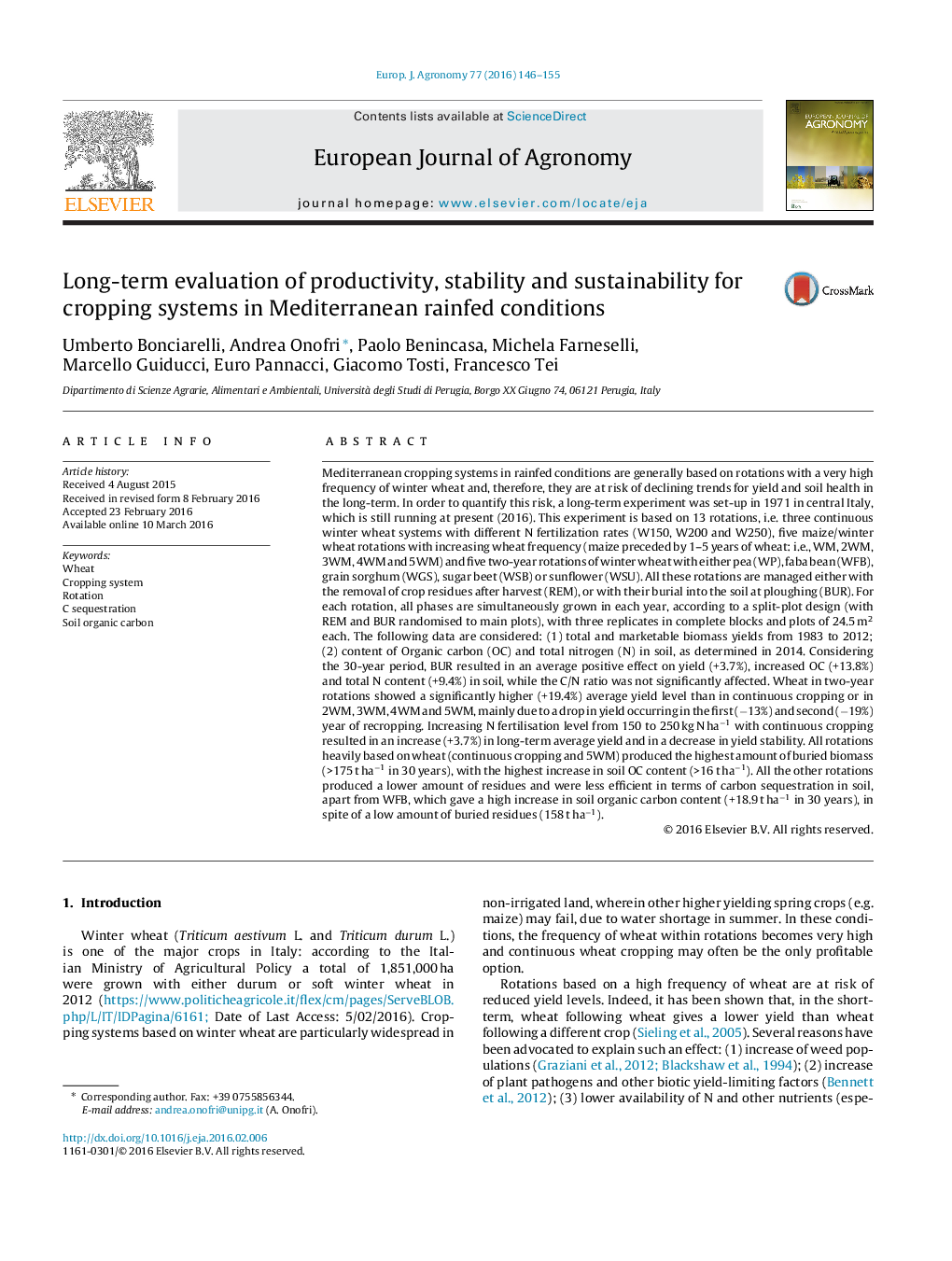| کد مقاله | کد نشریه | سال انتشار | مقاله انگلیسی | نسخه تمام متن |
|---|---|---|---|---|
| 4508717 | 1624448 | 2016 | 10 صفحه PDF | دانلود رایگان |
• A 43-year experiment in Mediterranean rainfed conditions compared 26 wheat-based cropping systems.
• Burial of crop residues increased yield (+3.7% on average), OC (+13.8%) and N content (+9.4%) in soil.
• Wheat in two-year rotations yielded more than in continuous cropping (+19.4% on average).
• Rotations heavily based on wheat were the most efficient in terms of carbon sequestration in soil.
• Buried biomass after 43 years was higher than 175 t ha−1 (+ 16 t ha−1 organic matter content in soil).
Mediterranean cropping systems in rainfed conditions are generally based on rotations with a very high frequency of winter wheat and, therefore, they are at risk of declining trends for yield and soil health in the long-term. In order to quantify this risk, a long-term experiment was set-up in 1971 in central Italy, which is still running at present (2016). This experiment is based on 13 rotations, i.e. three continuous winter wheat systems with different N fertilization rates (W150, W200 and W250), five maize/winter wheat rotations with increasing wheat frequency (maize preceded by 1–5 years of wheat: i.e., WM, 2WM, 3WM, 4WM and 5WM) and five two-year rotations of winter wheat with either pea (WP), faba bean (WFB), grain sorghum (WGS), sugar beet (WSB) or sunflower (WSU). All these rotations are managed either with the removal of crop residues after harvest (REM), or with their burial into the soil at ploughing (BUR). For each rotation, all phases are simultaneously grown in each year, according to a split-plot design (with REM and BUR randomised to main plots), with three replicates in complete blocks and plots of 24.5 m2 each. The following data are considered: (1) total and marketable biomass yields from 1983 to 2012; (2) content of Organic carbon (OC) and total nitrogen (N) in soil, as determined in 2014. Considering the 30-year period, BUR resulted in an average positive effect on yield (+3.7%), increased OC (+13.8%) and total N content (+9.4%) in soil, while the C/N ratio was not significantly affected. Wheat in two-year rotations showed a significantly higher (+19.4%) average yield level than in continuous cropping or in 2WM, 3WM, 4WM and 5WM, mainly due to a drop in yield occurring in the first (−13%) and second (−19%) year of recropping. Increasing N fertilisation level from 150 to 250 kg N ha−1 with continuous cropping resulted in an increase (+3.7%) in long-term average yield and in a decrease in yield stability. All rotations heavily based on wheat (continuous cropping and 5WM) produced the highest amount of buried biomass (>175 t ha−1 in 30 years), with the highest increase in soil OC content (>16 t ha−1). All the other rotations produced a lower amount of residues and were less efficient in terms of carbon sequestration in soil, apart from WFB, which gave a high increase in soil organic carbon content (+18.9 t ha−1 in 30 years), in spite of a low amount of buried residues (158 t ha−1).
Journal: European Journal of Agronomy - Volume 77, July 2016, Pages 146–155
